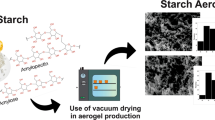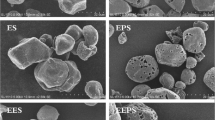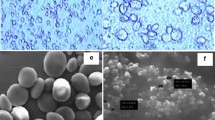Abstract
Preparation of starch-based aerogel by freeze-drying technique is considered as a suitable method for practical production due to its reasonable cost and controllable process. However, the low expansion rate of this method limits the application of adsorption and transport. In this study, through some pretreatment methods, such as adding glycerol and NaHCO3, and using double-roll extrusion, etc., the volume of the internal pores of starch aerogel was effectively increased, and the expansion rate was significantly improved. Meanwhile, a two-layer BP (back propagation) neural network model was established to predict the expansion rate. The result shows that the established BP network prediction model can accurately predict the target. Meanwhile, as the mass of glycerol increases, the expansion rate first increases and then decreases. When the mass of glycerol reaches 30 g, the expansion rate reaches the maximum value of 13.7%. As the mass of NaHCO3 increases, the expansion rate also increases first and then decreases. With the continuous increase of the double-roll extrusion time, the expansion rate will continue to increase. The simple pretreatment methods have a significant effect on improving the expansion rate of starch aerogel, which expands the application range. At the same time, the successfully applied BP network prediction model can improve production efficiency.
Graphical abstract











Similar content being viewed by others
References
Hiremani VD, Gasti T, Masti SP, Malabadi RB, Chougale RB (2022) Polysaccharide-based blend films as a promising material for food packaging applications: physicochemical properties. Iran Polym J 31:503–518
Nasrollahzadeh M, Sajjadi M, Iravani S, Varma RS (2021) Starch, cellulose, pectin, gum, alginate, chitin and chitosan derived (nano) materials for sustainable water treatment: a review. Carbohydr Polym 251:116986–117016
Nesic A, Gustavo CB, Suzana DB, Davidovic S, Radovanovic N, Delattre C (2020) Prospect of polysaccharide-based materials as advanced food packaging. Molecules 135:1–35
Deepak K, Lele SS (2018) Cross-linking effect of polyphenolic extracts of Lepidium sativum seedcake on physicochemical properties of chitosan films. Int J Biol Macromol 114:1240–1247
Liu C, Tan Y, Xu K, Hua M, Huo XH, Sun YS (2018) A novel designed high strength and thermoresponsive double network hydrogels cross-linked by starch-based microspheres. Iran Polym J 27:889–897
Cinelli PA, Chiellini E, Lawton JW, Imam SH (2006) Foamed articles based on potato starch, corn fibers and poly(vinyl alcohol). Polym Degrad Stab 91:1147–1153
Davis G, Song JH (2006) Biodegradable packaging based on raw materials from crops and their impact on waste management. Ind Crops Prod 23:147–161
Wang Y, Huang JJ, Zhou N (2015) Incorporating PLS model information into particle swarm optimization for descriptor selection in QSAR/QSPR. J Chemomet 29:627–636
Torres FG, Commeaux S, Troncoso OP (2013) Starch-based biomaterials for wound-dressing applications. Starch 65:543–551
Khazaei A, Sarmasti N, Seye JY (2016) Quantitative structure activity relationship of the curcumin-related compound using various regression methods. J Mol Struct 1108:168–178
Antonyuk S, Heinrich S, Gurikov P, Raman S, Smirnova I (2015) Influence of coating and wetting on the mechanical behavior of highly porous cylindrical aerogel particles. Powder Technol 285:34–43
Li YQ, Samad YA, Polychronopoulou K, Alhassan SM, Liao K (2014) Carbon aerogel from winter melon for highly efficient and recyclable oils and organic solvents absorption. ACS Sustain Chem Eng 2:1492–1497
Liu S, Yao F, Oderinde O, Zhang Z, Fu G (2017) Green synthesis of oriented xanthan gum-graphene oxide hybrid aerogels for water purification. Carbohydr Polym 174:392–399
Ojogbo E, Ogunsona EO, Mekonnen TH (2020) Chemical and physical modifications of starch for renewable polymeric materials. Mater Today Sustain 7:100028
Zeng GS, Hu C, Zou S, Zhang L, Sun G (2019) BP neural network model for predicting the mechanical performance of a foamed wood-fiber reinforced thermoplastic starch composite. Polym Compos 40:3923–3928
Zuo L, Zhang Y, Zhang L, Miao YE, Fan W, Liu T (2015) Polymer/carbon-based hybrid aerogels: preparation, properties and applications. Materials 8:6806–6848
Jalem R, Nakayama M, Kasuga T (2014) An efficient rule-based screening approach for discovering fast lithium-ion conductors using density functional theory and artificial neural networks. J Mater Chem A 2:720–734
Hamadache M, Benkortbi O, Hanini S, Amrane A, Khaouane L, Moussa CS (2016) A quantitative structure activity relationship for acute oral toxicity of pesticides on rats: validation, domain of application and prediction. J Hazard Mater 303:28–40
Zhao Q, Du Z, Yao W, Yao Y, Li Z, Shi Y, Chen L, Liao W (2022) Precipitable water vapor fusion method based on artificial neural network. Adv Space Res 70:85–95
Zhang YY, Pan BC (2014) Modeling batch and column phosphate removal by hydrated ferric oxide-based nano composite using response surface methodology and artificial neural network. Chem Eng J 249:111–120
Li M, Huang X, Liu H, Liu B, Wu Y, Wang L (2015) Solubility prediction of supercritical carbon dioxide in 10 polymers using radial basis function artificial neural network based on chaotic self-adaptive particle swarm optimization and K-harmonic means. RSC Adv 5:45520–45527
Filson PB, Dawson-Andoh BE, Schwegler-Berry D (2009) Enzymatic-mediated production of cellulose nanocrystals from recycled pulp. Green Chem 11:1808–1814
Bagheri-Khoulenjani S, Taghizadeh SM, Mirzadeh H (2009) An investigationon the short-term biodegradability of chitosan with various molecular weights and degrees of deacetylation. Carbohydr Polym 78:773–778
Chen L, Wang X, Straff R, Blizard K (2002) Shear stress nucleation in microcellular foaming process. Polym Eng Sci 42:1151–1158
Willet JL, Shorgen RL (2002) Processing and properties of extruded starch/plymer foams. Polymer 4:5935–5947
Wang L, Shogren RL, Carriere C (2000) Preparation and properties of starch-polyester laminate sheets by coextrusion. Polym Eng Sci 40:499–506
Cheng W, Chen J (2010) Impact of ultrasonic treatment on properties of starch film-forming dispersionand the resulting films. Carbohydr Polym 81:707–711
Liu TY, Ma Y, Yu SF, Shi J, Xue S (2011) The effect of ball milling treatment on structure and porosity of maize starch granule. Innov Food Sci Emerg Technols 12:586–593
Geng Y, Li K, Simonsen J (2004) Effects of a new compatibilizer system on the flexural properties of wood-polyethylene composites. J Appl Polym Sci 91:3667–3672
Author information
Authors and Affiliations
Corresponding author
Rights and permissions
Springer Nature or its licensor holds exclusive rights to this article under a publishing agreement with the author(s) or other rightsholder(s); author self-archiving of the accepted manuscript version of this article is solely governed by the terms of such publishing agreement and applicable law.
About this article
Cite this article
Sun, G., Zeng, G., Hu, C. et al. Starch-based aerogel prepared by freeze-drying: establishing a BP neural network prediction model. Iran Polym J 32, 37–44 (2023). https://doi.org/10.1007/s13726-022-01105-0
Received:
Accepted:
Published:
Issue Date:
DOI: https://doi.org/10.1007/s13726-022-01105-0




